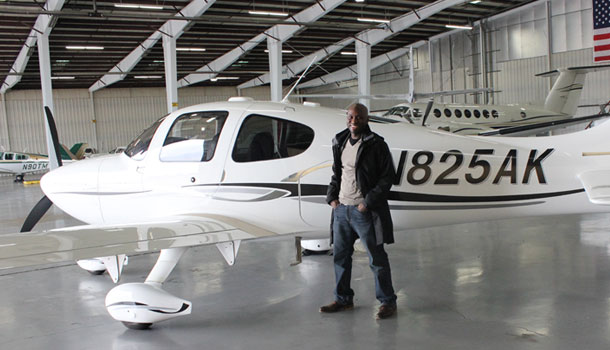
By/// Anslem Samuel Rocque
When most folks venture outside the boundaries of their state lines, flying in a plane is a likely option. But how many of us actually get to fly the plane? Chances are the answer would be very few—if any at all. Truthfully, the average person has probably never thought of it as a viable option. But speaking from personal experience, it should.
The opportunity to pilot my own aircraft presented itself when I received an email from Nicole Lasorda of LetsGoFlying.com, the Aircraft Owners & Pilots Association’s (AOPA) flight training initiative. As the company’s name would suggest, they provide individuals who have an interest in aviation the chance to learn as much as they can through a series nationwide flight schools, which are staffed by a crop of top-notch flying aces. As someone who’s jumped out of a plane twice, the chance to view the world from the cockpit intrigued me so I signed up.
My co-pilot (or was that my title here as the novice?) for this adventure was Al Waterloo of SimpleFlight.net. Our destination was the Leading Edge Flying Club, which is located in Hangar 5 at the Chicago Executive Airport (PWK) in Wheeling, IL. Our aircraft for the day was not a jet (wouldn’t that be ironic?) but a 1979 Piper Dakota, a four-seat propeller aircraft with a 235 HP car engine. Despite the age of the plane, it included many modern updates such as XM Radio/Weather, a Garmin GTN650 Touch Screen GPS NavCom and a Garmin Area 560 with weather and SafeTaxi.
But enough of the technical stuff, let’s get down (or up) to flying…
Before doing that, though, you have to first check the weather. And, no, your local forecaster’s morning report or smartphone app won’t cut it, weather.gov is the aviation industry’s preferred source. Flying is serious business and every pilot is responsible for knowing what up-to-the-minute conditions he or she might come across while in the air. So going to the command center to see what the weather on the radar for your intended flight path looks like is par for the course.
Once that’s done, there’s a series of pre-flight checks that must take place, such as making sure the fuel (which is blue) isn’t diluted by rain water and that there aren’t any visible signs of damage to the aircraft. Being that the Piper Dakota is relatively small the inspection goes by much faster than your standard commercial aircraft.
While some may assume flying a plane is much like driving a car, there are some major differences between the two. Namely, is the fact that when a plane moves on the ground (known as taxing) it’s not the steering wheel that controls your direction, it’s the floor pedals. Push down on the left pedal while the throttle is engaged and the grounded aircraft will veer in that direction. Push down on the right pedal and you’ll get the same results. Press both pedals simultaneously to stay on a straight line, and push forward with the tips of your toes to come to a stop. It takes a little practice to get used to the idea of not using your hands to steer, but after a few taxing lessons it should become second nature. Just be sure to not try the same thing when you get back behind the wheel of your car.
Before takeoff pilots are required to run through a series of last minute system checks, ranging from ensuring the throttle operates properly when fully engaged to verifying that the wing rudders respond correctly when the steering wheel is turned. The pre-flight list is not something done off of memory, it’s a written document that pilot’s read through each and every flight to ensure an important step is not overlooked. Once all systems are a go and the air traffic control tower gives the green light, you’re clear to taxi toward your assigned lane and await final takeoff clearance.
Here’s where the real fun begins.
CLICK HERE TO CONTINUE READING…


